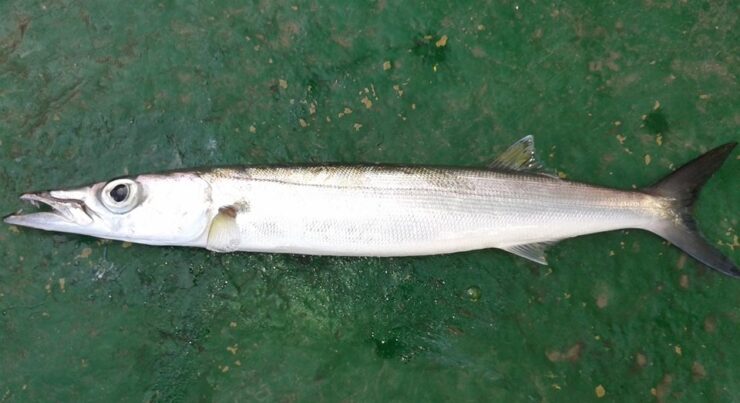Great Barracuda (Spyraena barracuda) has unique dental work. The teeth appear randomly placed but all Barracuda have the exact same dental arrangement unless of course a tooth is broken. Their long needlelike teeth actually each have their own hole on the opposing jaw.
Barracuda are found worldwide in tropical waters. There are six separate species, the largest being the Great Barracuda! In the Atlantic the Great Barracuda ranks as the No.1 carrier of ciguatera poisoning. Although most don’t carry the toxin.
Features of Small Barracuda
Small barracudas are known for their streamlined, elongated bodies and sharp teeth. They have a silver color with shades of green or gray on their backs, and dark spots or bars on their sides. These fish typically grow up to 2 feet long, although some can reach up to 4 feet. Barracudas have two rows of teeth: an outer row of small, sharp teeth for tearing flesh and an inner row of longer, dagger-like teeth for firmly grasping prey.
Habitat
Small barracudas inhabit tropical and subtropical oceans around the world. They prefer shallow waters near coral reefs, seagrass beds, and mangroves. These environments provide abundant prey and protection from larger predators. Juveniles often form schools for safety, while adults tend to be more solitary. They can be found in the Atlantic, Pacific, and Indian Oceans, as well as the Caribbean and the Red Sea.
Diet
Small barracudas are carnivorous and primarily feed on smaller fish such as mullets, jacks, and herrings. They also consume shrimp and squid. Their hunting technique relies heavily on their excellent eyesight to spot prey, followed by swift, aggressive strikes using their sharp teeth to tear apart larger prey or swallow smaller prey whole.
Behavior
Juvenile barracudas often form schools that can include hundreds of young fish for added protection. In contrast, adult barracudas are more solitary. They are aggressive and competitive hunters, sometimes engaging in scavenging by consuming parts of prey left behind by other predators. They are known to be opportunistic feeders, taking advantage of any available prey.
Reproduction
Barracudas reach sexual maturity at around 2 to 3 years old. During the mating season, males engage in courtship displays to attract females. Females release thousands of eggs into the water, which are then fertilized by males. The eggs float in open water until they hatch into larvae. Juveniles initially live in shallow, vegetated areas before moving to coral reefs as they grow. Barracudas can live up to 14 years in the wild.
Interaction with Humans
Although barracudas have a fearsome reputation, they generally avoid humans. However, they may mistake shiny objects for prey, leading to rare instances of bites. These incidents can be prevented by avoiding reflective items while swimming or diving in waters inhabited by barracudas.
Use and Benefits
Small barracudas are popular in sport fishing due to their fighting ability. They are also sometimes caught for food, though their flesh can occasionally contain toxins that cause ciguatera poisoning. Despite this, they remain a valued catch for recreational anglers.
Last Words
Small barracudas are fascinating predators with distinctive physical features and behaviors. They inhabit tropical and subtropical waters, often near coral reefs, seagrass beds, and mangroves. These fish are efficient hunters, relying on their speed and sharp teeth to catch prey. While generally avoiding humans, they can occasionally mistake shiny objects for food.

